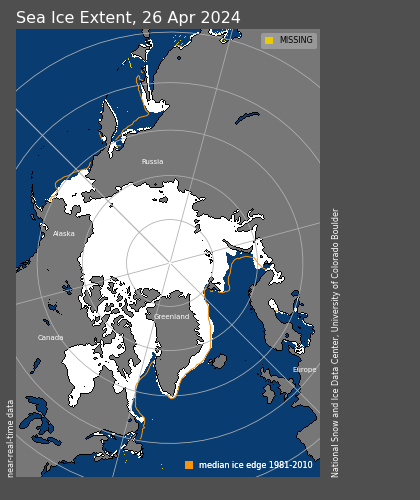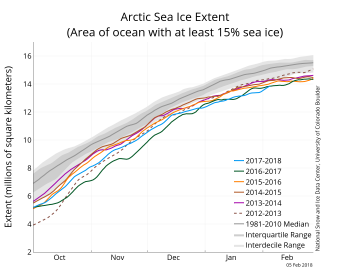Environment & Energy
Related: About this forumNSIDC - Global Sea Ice Extent At Record Low; Nearly All Of Arctic 5F Or More Above Average
January of 2018 began and ended with satellite-era record lows in Arctic sea ice extent, resulting in a new record low for the month. Combined with low ice extent in the Antarctic, global sea ice extent is also at a record low.
Overview of conditions

The new year was heralded by a week of record low daily ice extents, with the January average beating out 2017 for a new record low. Ice grew through the month at near-average rates, and in the middle of the month daily extents were higher than for 2017. However, by the end of January, extent was again tracking below 2017. The monthly average extent of 13.06 million square kilometers (5.04 million square miles) was 1.36 million square kilometers (525,000 square miles) below the 1981 to 2010 average, and 110,000 square kilometers (42,500 square miles) below the previous record low monthly average in 2017.
The pattern seen in previous months continued, with below average extent in the Barents and Kara Seas, as well as within the Bering Sea. The ice edge remained nearly constant throughout the month within the Barents Sea, and slightly retreated in the East Greenland Sea. By contrast, extent increased in the Gulf of St. Lawrence, off the coast of Newfoundland, in the eastern Bering Sea and the Sea of Okhotsk. Compared to 2017, at the end of the month, ice was less extensive in the western Bering Sea, the Sea of Okhotsk and north of Svalbard, more extensive in the eastern Bering Sea and in the Gulf of St. Lawrence. Overall, the Arctic gained 1.42 million square kilometers (548,000 square miles) of ice during January 2018.
Conditions in context

Air temperatures at the 925 hPa level (about 2,500 feet above sea level) remained unusually high over the Arctic Ocean (Figure 2b). Nearly all of the region was at least 3 degrees Celsius (5 degrees Fahrenheit) or more above average. The largest departures from average of more than 9 degrees Celsius (16 degrees Fahrenheit) were over the Kara and Barents Seas, centered near Svalbard. On the Pacific side, air temperatures were about 5 degrees Celsius (9 degrees Fahrenheit) above average. By contrast, 925 hPa temperatures over Siberia were up to 4 degrees Celsius (7 degrees Fahrenheit) below average. The warmth over the Arctic Ocean appears to result partly from a pattern of atmospheric circulation bringing in southerly air, and partly from the release of heat into the atmosphere from open water areas. Sea level pressure was higher than average over the central Arctic Ocean, stretching towards Siberia. This pattern, coupled with below average sea level pressure over the Chukchi and Bering seas, helped to move warm air from Eurasia over the central Arctic Ocean.
Ice growth for January averaged 37,000 square kilometers (14,000 square miles) per day, close to the average rate for the month of 42,700 square kilometers per day (16,486 square miles per day). In the Barents Sea, the ice extent was the second lowest during the satellite data record. Ice conditions in this region of the Arctic are increasingly viewed as important in having downstream effects on atmospheric circulation. These proposed links include northward expansion of the Siberian High and cooling over northern Eurasia.
EDIT
http://nsidc.org/arcticseaicenews/